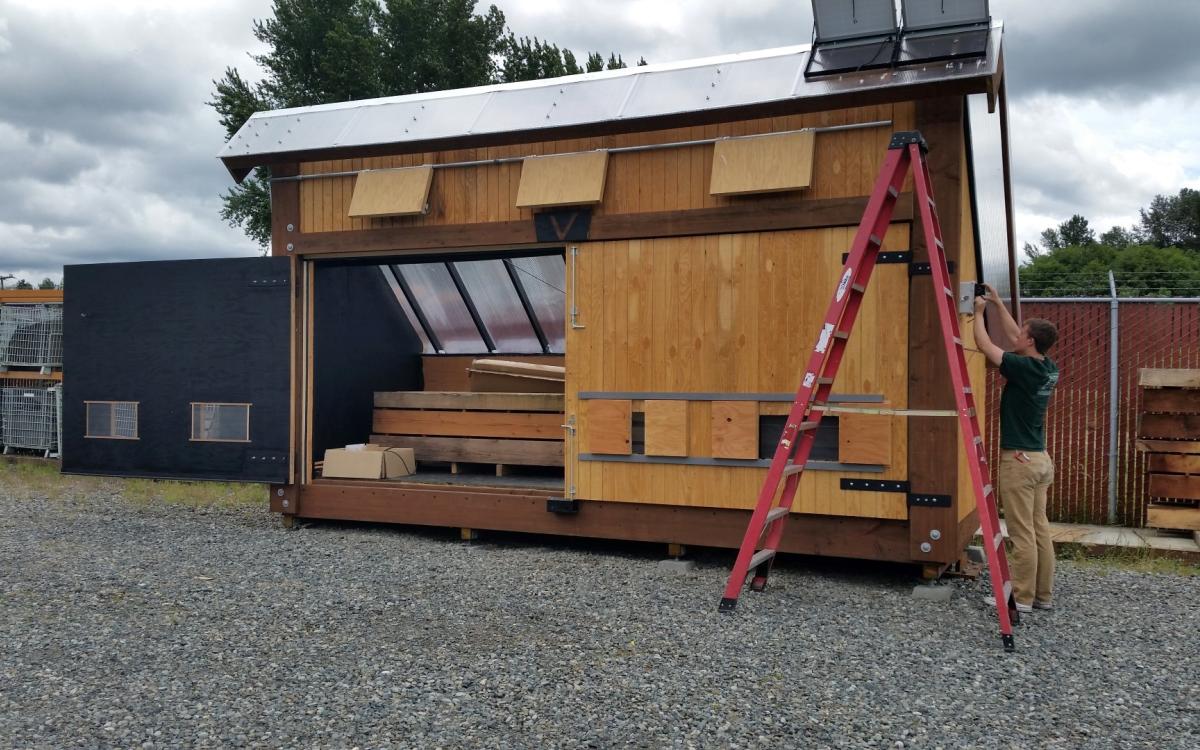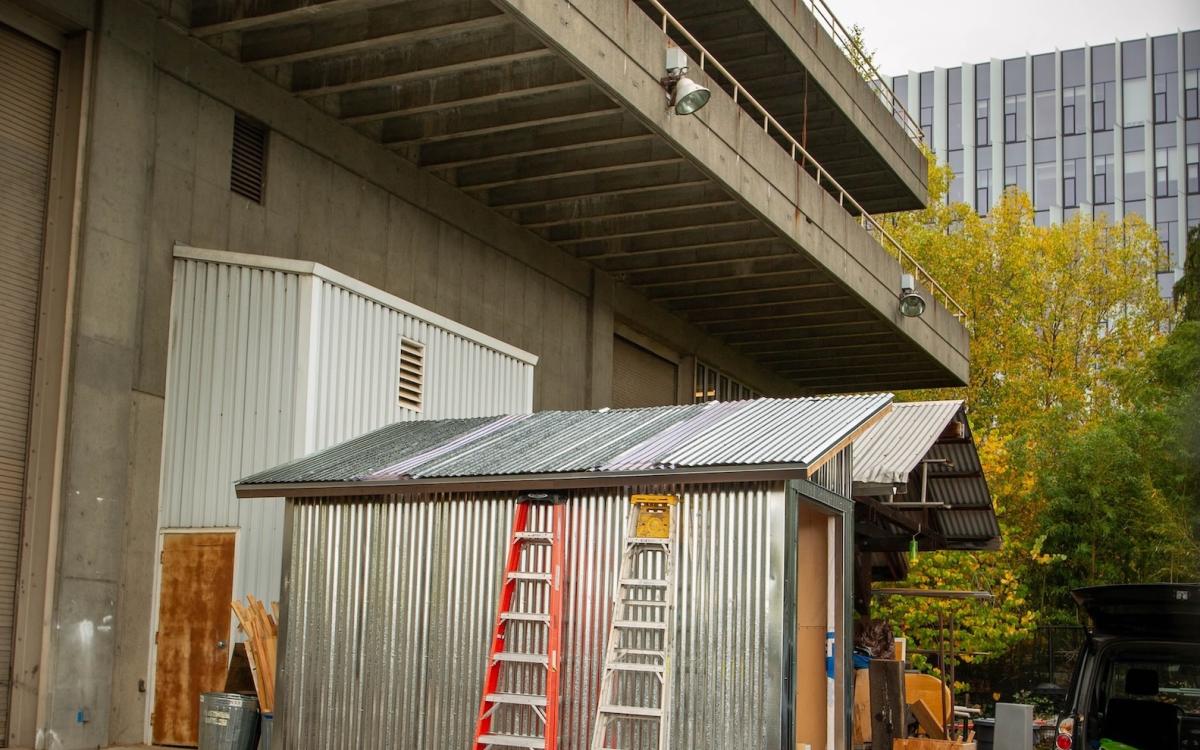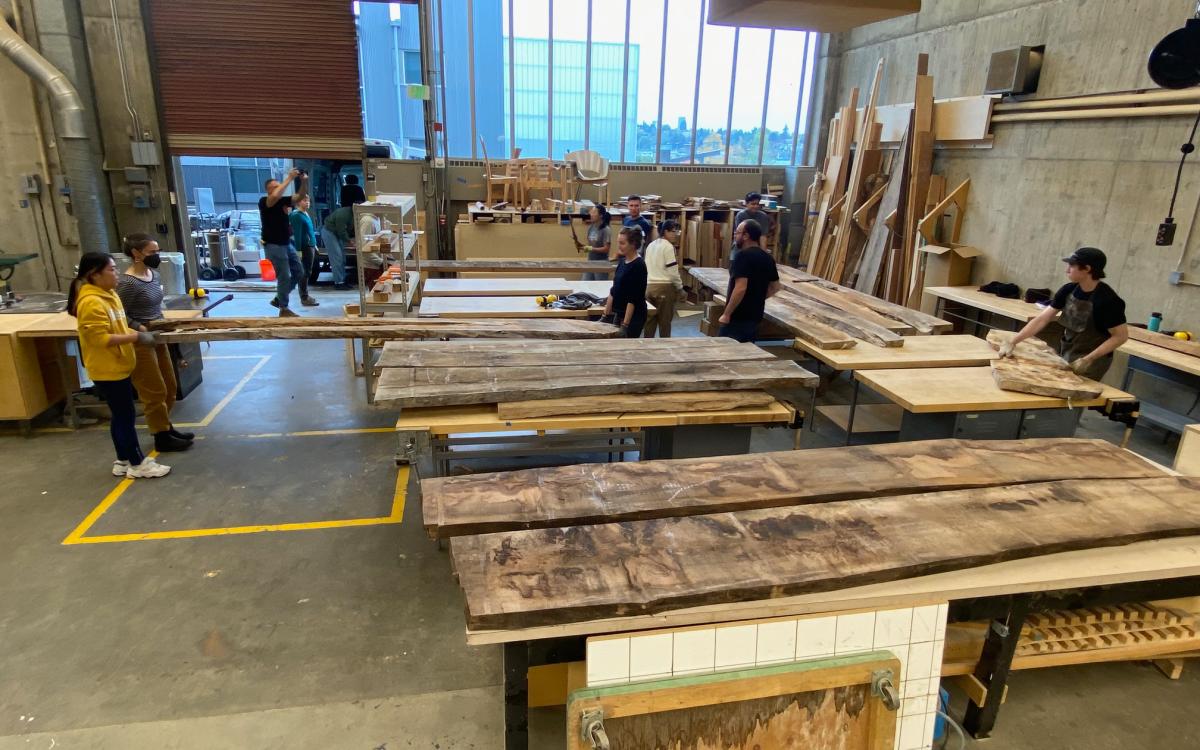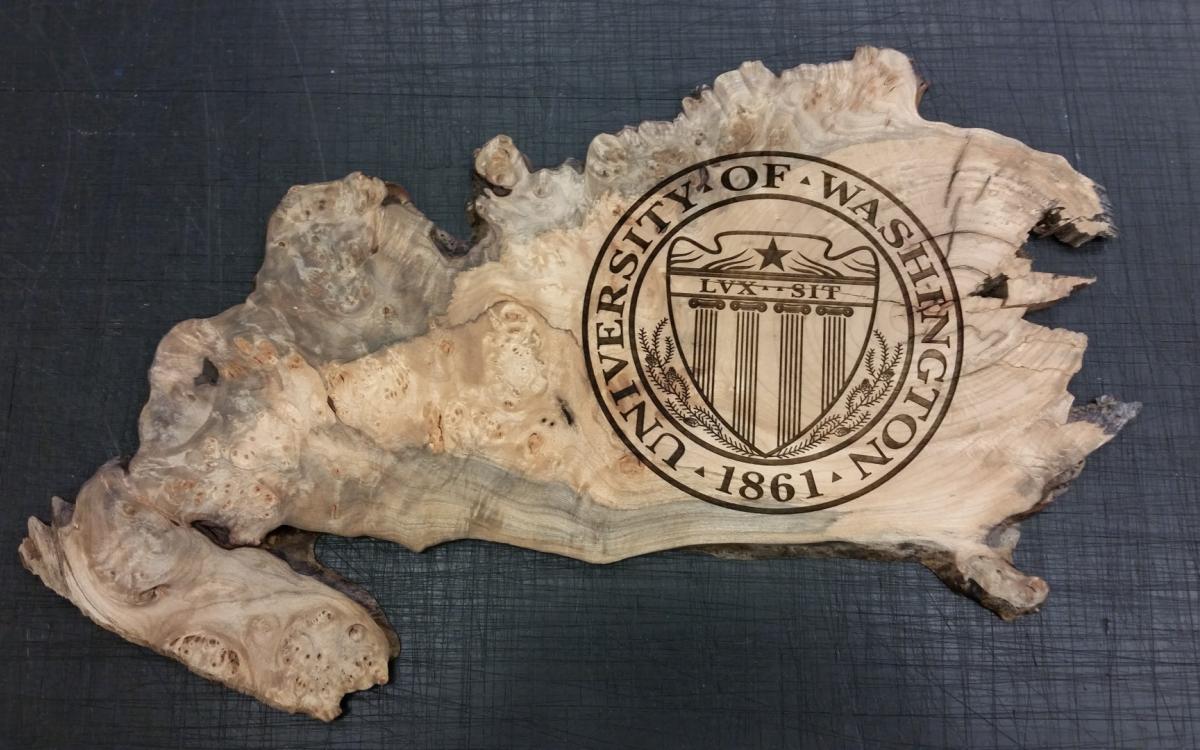At a glance
The Salvage Wood Program seeks $72,400 to build an insulated, climate-controlled storage facility for salvaged wood and… Read full summary
- Funding received
- 2023-2024
- Large
- Awarded
- $72,400
- Funding partners
-
- Services and Activities Fee (SAF)
The Salvage Wood Program seeks $72,400 to build an insulated, climate-controlled storage facility for salvaged wood and integrate the program into student coursework in the College of Built Environments. Established in 2017, the program repurposes campus trees into usable lumber, aligning with UW's sustainability goals. The new facility will prevent wood deterioration, improve inventory efficiency, and provide affordable, ethically sourced materials for students. CSF funding will support initial operations, with long-term financial sustainability ensured through partnerships and revenue from wood sales. The project promotes resource conservation, waste reduction, and equitable access for students.
The Salvage Wood Program seeks $72,400.00 to construct an insulated, climate-controlled storage facility for the campus's salvaged wood and to streamline the implementation of the program into regular course procedures for student-use within the College of the Built Environments. The Salvage Wood Program is a collaborative partnership between the University of Washington's Grounds Management, Finish Carpentry, and the College of Built Environments, and was initially sponsored by the Campus Sustainability Fund and integrated into campus operations in 2017 (https://facilities.uw.edu/catalog/salvage-wood; https://facilities.uw.edu/catalog/salvage-wood/about-salvage-wood-program). As a gold rated university recognized by the Association for the Advancement of Sustainability in Higher Education, UW is committed to responsibly using resources, reducing waste and carbon emissions, prioritizing sustainable practices, and galvanizing the community to follow suit. The Salvage Wood Program is a proud showcase of this commitment. The program thoroughly hits Target VIII and IX of UW's 2024 Sustainability Action Plan, which prioritize the reduction of energy use and waste. Since 2016, the program has repurposed 19,000 board feet of lumber from trees within UW Seattle and Bothell campus. However, the program is facing a dilemma due to a lack of indoor drying storage space, which causes some wood to be stored outdoors indefinitely without temperature or humidity regulations. Being exposed to environmental elements for too long adversely affects the wood and over time some of the wood deteriorates, can no longer be repurposed, and is discarded. The program also needs an improvement in inventory efficiency and a fresh revenue stream to recoup the costs of running the program.
The goal is to have the CSF financially support the construction of the storage facility, which will ensure all the wood removed from campus will be preserved for the maximum amount of time and will improve the quality and quantity of products generated. The storage facility will be outside of Gould Hall, where students will have priority access to purchase the wood for assigned course projects or for personal use. For two years after receiving the funds and implementing the program into courses, the CSF will purchase the wood for student-use to relieve the financial burden from students. After two years, the College of Built Environments will purchase the wood and then students will have an opportunity to purchase ethically sourced wood on campus at a discounted rate. This supports UW's Diversity Blueprint by alleviating some of the financial burden from students and increasing equal opportunity for all students who want to be involved. With CSF funding the initial stage of the program, this will facilitate a seamless transition of the program into course procedures and ensure that the program will be effective before turning fiscal responsibility over to the college. Additionally, this will create a foundation for the Salvage Wood Program to become more accessible for student-use across campus and lay the groundwork for the program to be implemented into other colleges and departments. The Salvage Wood Program operates as a nonprofit and so this new revenue stream will be vital in recouping costs to maintain the sustainability of the program and keeping that revenue within UW.
Marlee Theil
Project lead
- mtheil@uw.edu
- Affiliation
- Student
Sara Shores
Team member
- shoress@uw.edu
- Affiliation
- Staff
The Salvage Wood Program is a collaborative partnership between University of Washington Grounds Management, Maintenance and Construction, and the College of Built Environments, and was initially sponsored by the Campus Sustainability Fund and implemented into campus procedures in 2015 (https://facilities.uw.edu/catalog/salvage-wood; https://facilities.uw.edu/catalog/salvage-wood/about-salvage-wood-progr…). As a gold rated university recognized by the Association for the Advancement of Sustainability in Higher Education, UW is committed to responsibly using resources, reducing waste and carbon emissions, prioritizing sustainable practices, and galvanizing community involvement. The Salvage Wood Program is a proud showcase of this commitment.
Grounds Management oversees approximately 10,000 trees on campus and ensures that all trees are planted methodically and with purposeful intention. Campus trees are a significant asset in both actual value and investment over time. Eventually, these trees will be removed because of natural decline or death, as a preventative measure to avoid potential hazards, or as part of a construction project. By keeping the tree material on campus, money is saved in disposal cost, less energy is used in waste transportation, some of the asset value of the tree is retained by being incorporated into campus projects, and the investment made into that tree over time is preserved. The program repurposes these trees to survive long past their removal and to preserve UW history and culture in timeless products. The processed wood is available for student, faculty, and administration projects; capital projects relating to Maintenance and Construction needs; and custom products such as nameplates, signs, and furniture pieces.
Before the wood can be renewed it is imperative that it goes through a series of drying stages both in open-air conditions and in a kiln, which could take up to three years total. These stages are executed and monitored by UW Carpenters. The program is facing a dilemma due to a lack of indoor drying storage space, which causes some wood to be stored outdoors without temperature or humidity regulations. Being exposed to environmental elements adversely affects the wood and after one year the wood deteriorates, can no longer be repurposed, and is discarded. These conditions also reduce the amount, type, and quality of products created, and consequently reduce the success and sustainability of the program. In addition to storage issues, the program needs a fresh revenue stream and an improvement in efficiency.
To combat these problems and through interdisciplinary collaborations between UW Carpenters, Grounds Management, and students and staff of the College of Built Environments, an idea was generated to build a new storage facility to dry the wood. This solution will protect the wood from harsh environmental conditions and preserve wood integrity for the maximum amount of time to maintain the zero-waste nature of the program. The facility will be an insulated, climate-controlled, external addition to Gould Hall. Design and construction of the infrastructure will be spearheaded by staff members of the College of Built Environments, and students will have an opportunity to participate and further develop their technical skills in architectural design, engineering, and project management. Several classes, such as the Furniture Studio course that operates every quarter, will utilize the wood for assigned projects. The goal is to have the CSF grant fund the construction of the storage facility and provide financial support as the program is reenergized. For two years after implementation, grant funds will be utilized to purchase the wood for students to use in classes. Once the program is fully operational and efficient, the College will purchase the wood for student use. With the CSF grant and then the College purchasing the wood, this supports UW’s Diversity Blueprint by releasing the financial burden from students and ensuring equal opportunity for all students who want to be involved. Also, this new revenue stream from the College will be vital in recouping costs to maintain the sustainability of the program.
This storage facility will not only alleviate revenue and storage issues, but it will also improve logistics and prosperity of the program. As opposed to the current horizontal storage, which makes choosing wood difficult, the wood in the facility will be stored vertically and in turn will allow students to easily choose wood based on species, appearance, and size. The wood will also be more readily available compared to the current procedure that involves students setting a specific date and time once per quarter to visit the carpenter storage area. The facility will improve student accessibility to the wood, encourage the use of ethically sourced materials, educate the students about eco-friendly habits, and reduce costs compared to traditional lumber yards. Also noteworthy is that the facility will provide ample educational opportunities for students to learn about the extensive process of drying and managing wood, which is such an important economical practice that entire careers are dedicated to it.
UW carpenters will employ funding to plane the wood to make it more appealing and marketable to students. Planing involves smoothing and shaping the wood into a uniform strip for the purpose of refining quality and visibility of the color and grain. This will increase the likelihood of students selecting the program’s wood rather than off campus sources because they are inclined to invest in wood that is planed prior to purchase. Smaller wood pieces and chips produced while milling will be turned into compost at UW farm or utilized for cooking in the farm’s wood burning stove. Funding will also support the carpenters to provide guided tours of the carpentry shop to students once per quarter to facilitate engagement with the kiln, sawmill, and wood production.
The carpenters and staff of the College of Built Environments will also claim responsibility and funding to track the wood and conduct consistent, accurate inventories. As the wood is processed and dried, each stage requires the input of information into a spreadsheet. Inventorying and identifying where the wood originated, when it was salvaged, and the age is a special and unique aspect of this program. Expertly tracking the wood ensures that the intrinsic value of the wood is maintained, and UW’s legacy of sustainable initiatives is preserved in the products. Executing quarterly inventories into normal procedures will streamline efficiency of the program and will ensure accurate stock and quantities to aid in future project planning.
The Salvage Wood Program has a legacy of contributing to UW’s Sustainability Action Plan, and the collaborators involved have proven their technical knowledge and project management skills to successfully support the program. The graduate appointee for Grounds Management will continue to monitor program success, track expenses, support educational and advertisement opportunities on campus, and coordinate with collaborators to meet deadlines. With additional funding to construct a storage facility and to support collaborators as they process and manage the wood, the program will continue to prioritize environmentally sound practices and to proudly exemplify UW’s sustainability commitment while engaging students, staff, and facility units.
Request amount and budget
How the project will react to funding reductions
If the Salvage Wood Program was awarded only a portion of the total requested amount, the first reduction would occur within Finish Carpentry and how they process the wood. Their goal is to plane the boards before student-use to make it more appealing and marketable. Planing involves smoothing and shaping the wood into a uniform slab for the purpose of refining quality and visibility of the color and grain. Planing the wood will increase the likelihood of students selecting salvaged wood rather than off campus sources because they are inclined to invest in wood that is planed prior to purchase. If this step was removed from the process $6,000 could be saved. Additionally, the goal is to have the CSF purchase the salvaged wood for student-use for two years after implementation to relieve the financial burden from students. Once the program is fully operational and efficient, the College will purchase the wood for student-use and then the students will have an opportunity to purchase ethically sourced wood from campus at a discounted rate. If the total requested amount must be reduced significantly, the CSF could purchase the salvage wood for student-use for only one year after implementation, which would save $19,000. However, the collaborators chose two years because developing and streamlining this new system will be an extensive process, and it will be critical to demonstrate the effectiveness and positive impact of the program before turning fiscal responsibility over to the College of Built Environments.
Plans for financial longevity
The Salvage Wood Program has a legacy of contributing to UW's Sustainability Action Plan since 2017. The collaborators involved have proven their passion for sustainability, technical knowledge in wood repurposing, and project management skills to successfully support the program indefinitely. This project is “shovel-ready” as soon as funds are received. A blueprint of the storage facility has been created with a detailed price breakdown for materials. A thorough, long-term schedule has been created to determine when the salvage wood will be processed within UW Carpentry, when wood will be transferred to Gould Hall, when inventories will be conducted, and when website and maps will be updated. Media teams have been alerted of the request for funds and are eager to spread the word of the Salvage Wood Program. All units involved speak highly of the program and have offered full, long-term support.
By laying the groundwork for the program to be implemented in the College of Build Environments, this can open future opportunities for other colleges and departments to easily become involved and utilize the wood. A system will be established for transferring funds and wood between campus entities, and once the inventory process has been finalized and streamlined, it can be managed by any individual within the College of Built Environments and Finish Carpentry. As the program continues to garner publicity around campus and to create opportunities for salvage wood purchases, additional revenue will be generated, which can be used to further expand the capacity and success of the program in the future. This solid foundation will ensure that the program has a steady revenue stream and will live long beyond the initial collaborator's involvement. With the Salvage Wood Program already being an integral part of campus procedures, the adjustments made over the next two years will only make the program more efficient and sustainable. The collaborators are confident in the continual management of the program and with their expertise and the CSF, the program will reach soaring new heights in sustainable impact, student involvement, education, and outreach.
Problem statement
Before the wood can be repurposed it is imperative that it goes through a series of drying stages both in open-air conditions and in a kiln, which could take up to three years total. These stages are executed and monitored by UW Carpenters. The program is facing a dilemma due to a lack of indoor drying storage space, which causes some wood to be stored outdoors without temperature or humidity regulations. Being exposed to environmental elements for too long adversely affects the wood and over time the wood deteriorates, can no longer be repurposed, and is discarded. Even if a portion of the wood can be salvaged, these conditions also reduce the amount, type, and quality of products created, and consequently reduce the success and sustainability of the program.
To combat these problems and through interdisciplinary collaborations between UW Carpenters, Grounds Management, and students and staff of the College of Built Environments, an idea was generated to build a new storage facility to dry the wood. The facility will be an insulated, climate-controlled, external addition to Gould Hall. This solution will protect the wood from harsh environmental conditions and preserve wood integrity for the maximum amount of time to maintain the zero-waste nature of the program. By constructing the storage facility at Gould Hall, the wood will be readily available for students to purchase for assigned course projects or personal use. The Salvage Wood Program operates as a nonprofit so this new revenue stream will be vital in recouping costs to maintain the sustainability of the program and keeping that revenue within UW. This storage facility will not only alleviate revenue and storage issues, but it will also improve logistics and prosperity of the program. By implementing the program into the College of Built Environments, the additional attention can boost interest and eventually the program can expand into other campus colleges and departments.
Measure the impacts
The sustainable impacts of the program will be measured in metrics quantifying the amount of wood salvaged and repurposed, and student involvement, which will be calculated through consistent, dynamic inventories. Both UW Carpenters and staff of the College of Built environments will claim responsibility and funding to streamline the inventory process. Inventorying and identifying where the wood originated on campus, when it was salvaged, and the species of the tree is a special and unique aspect of this program. Expertly tracking the wood ensures that the intrinsic value of the wood is maintained, and UW's legacy of sustainable initiatives is preserved in the products. These inventories will be an effective way to calculate precise quantitative values of the quantity of wood salvaged from campus. For example, current inventories show that 19,000 board feet of wood has been salvaged from both UW Seattle and Bothell campus since 2017. These values can then be utilized to estimate costs saved from disposal and costs saved by the students by purchasing wood at discounted rates compared to traditional lumber yards. The inventories can also provide metrics of student involvement because wood that is sent to the College of Built Environments will be tracked. Inventories will also improve efficiency and logistics of the program and will ensure accurate stock and quantities to aid in future project planning.
Education and outreach goals
The Salvage Wood Program has a specific outreach goal to impact a widespread campus audience even beyond the College of Built Environments. Although the program is starting within this college, the goal is to eventually expand to other colleges and departments within campus. Eventually, the program could even accept purchases from the public community. The overall goal is to educate UW entities to responsibly use resources, reduce waste and carbon emissions, prioritize sustainable practices, and galvanize the community to follow suit.
The Graduate Student Appointee for Grounds Management participates in annual events such as UW's Sustainability Fair and Earth Day Event, which are valuable occasions to educate students, faculty, staff and organizations within the community about the Salvage Wood Program. Plaques, signs, and a compost container produced from salvaged wood are proudly displayed and draw attention from the crowd to the program's possibilities and sustainable practices. Also noteworthy, collaborators of the program have already informed the Facilities Maintenance and Construction Media Blogger, the UW News team, and Washington Magazine about the funds being requested from CSF to advance the program. A video will be created which will focus on the construction of the storage facility and the collaboration between UW Facilities and students. Another video will follow along the entire salvage wood process from the decision to remove a tree; to milling, kiln drying, and transporting the wood to Gould Hall; to students working with the wood to create a beautiful, sustainable product. These videos will be publicly available and accessible through social media. A blog post will also be created and available through the UW News website and the UW homepage. The videos and blog will present the Salvage Wood Program in full glory from the accumulation of the wood to the creation of the product. By gathering public attention, the Salvage Wood Program is more likely to be integrated into new avenues within UW campus.
Prior to course registration dates each quarter, an email advertisement will be sent to all students within the College of Build Environments displaying a creative graphic and information regarding the Salvage Wood Program, the courses offered that prioritize the use of the salvaged wood, steps on how to access the wood if not enrolled in a course, and other general information about the sustainable initiative. Posters of the advertisement will also be hung in the buildings where the courses are held. This will encourage students to enroll in the courses or to use the wood for personal use, and it will keep environmentally sound practices at the forefront of their mind.
The Salvage Wood Program is a well-known program that has garnered favorable attention from campus and community entities. The program is proudly displayed on campus through benches, signs, and tables produced from salvaged wood with plaques designated to provide information about the program. The Salvage Wood Program website already contains a simple map pinpointing some of the trees that have been utilized within the program, trees that will be utilized in the future, and the location of final products (https://depts.washington.edu/ceogis/Public/SalvageWoodProgram/). With funding from the CSF, a more informative, detailed, and interactive GIS map will be generated to add to the website. The new map will illustrate the location on campus where the wood was salvaged with a picture of the original tree, and once a product is generated, a picture of the final product will be included as well. This map will enable individuals to follow the timeline of the wood and to establish a deeper connection with the timeless products created. It will also inspire to prioritize ethically sourced wood and also to maintain sustainable habits throughout daily life.
Student involvement
Students enrolled in courses within the College of Built Environments, such as the Furniture Design Studio, will utilize the salvaged wood for assigned projects. This course operates during three quarters each year with approximately fourteen students enrolled, which results in at least 42 students per year interacting with the wood. Other courses will also have access to utilize the wood, and eventually, the program could expand to other colleges and departments for an even greater student impact. Students also have the opportunity to purchase the wood for personal use.
As of right now, students purchase wood from an external lumberyard. This can be problematic because transportation of the wood can be complicated and involves the emission of carbon, and some students do not have access to vehicles. The lumber is also usually produced from timber plantations, which can be sustainable, but its sustainability is contingent upon responsible forest management and ethical harvesting practices, which is not guaranteed. With the Salvage Wood Program, students have the comfort of knowing their wood is ethically sourced and that their money is going back into a sustainable program to benefit campus and the environment.
The integration of the Salvage Wood Program into course procedures will provide ample educational opportunities for students to learn about the extensive process of drying and managing wood, which is such an important economical practice that entire careers are dedicated to it. Funding will also support the carpenters to provide guided student tours of the carpentry shop once per quarter to facilitate engagement with the kiln, the sawmill, and wood production. Another important opportunity for students is presented at the end of each quarter when the College of Built Environments hosts a public event in which students present the final projects they created during the courses. This event gathers students, faculty, staff, family, and friends, and additionally, community professionals are invited to evaluate student work, which could lead to future employment. Final projects can be left on display for one to two weeks. This provides another exciting way to spread the word about the ethical foundation that the Salvage Wood Program is built upon and gives students a public space to discuss their sustainable choices.




